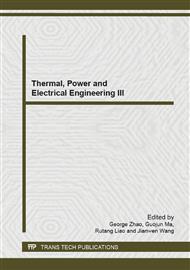[1]
Zhu Baoguo, Wang Zhenlong. Development and application of electroforming technology. Electroforming & mold, 2006, 5.
Google Scholar
[2]
Huang Chao, Li Hongyou, Jiang Kaiyong. Research and development of electroforming technology. Electroplanting & Pollution control, 2010, 30(6): 1-4.
Google Scholar
[3]
Wang Wenzhong, Electroforming technology and the applications. Plating and Finishing, 1998, 17(1): 36-39.
Google Scholar
[4]
Zhao Jianfeng, Zhu Di. Pulse current electroforming and Research on the quality of electroforming layer. Materials protection, 1997, 30(3): 3-5.
Google Scholar
[5]
Liulan Bo, Wu Meng Hua. Ultrasound - Pulse electroforming process parameters effects on the grain size of the nickel electroforming layer. Mechanical engineering materials . 2012, 36(3): 22-25.
Google Scholar
[6]
Kong Xiangdong, Zhang Yulin, Song Huiying. Development and application of LIGA technology. Micro electronic technology, 2004(5): 13-18.
Google Scholar
[7]
Yi Futing, Wu Jianwu, Xi Dingchang. Microfabrication technology- LIGA technology. Microfabrication technology, 1993(4): 1-7.
Google Scholar
[8]
Yang Dachun, Yun Naizhang. Combined soluble conformal anode electroforming technology. New Technology & New Process, 2004(2): 33-34.
Google Scholar
[9]
Ra'a A. Said. Adaptive tip-withdrawal control f or reliable micro fabrication by localized electrodeposition [J]. Journal of Microelectron mechanical Systems, 2004, 13(5): 822-832.
DOI: 10.1109/jmems.2004.835774
Google Scholar
[10]
Cheng Chen. The main components of electrolyte and its effect on mechanical properties of electro deposition. Chemical engineering and equipment, 2008(7): 14-15.
Google Scholar
[11]
Wang Xuran, Feng Xiaoming, Wang Zhong. Preparation process of Fe-SiCp composite electroforming layer. Mechanical Engineering Materials . 2006, 30(9): 32-43.
Google Scholar
[12]
Qian Wanghuan, Qu Ningsong, Zhu Zengwei. Study on t continuous fiber reinforced composite electroforming metal. 15th National Special Processing Conference Proceedings (Next volume) 2013: 18-22.
Google Scholar
[13]
Malone GA, Winkelman DM. High Performance alloy Electroforming. NASA-N 89-16041, 206P.
Google Scholar
[14]
Zhang Yubin. deposition of iron-nickel alloy film, Journal of Hunan University, (2009).
Google Scholar
[15]
Wang Ruiyong, Long Jinming. Research progress of electroformed nickel alloy [J]. Plating and finishing, 2009(3).
Google Scholar
[16]
Yang Dongfang, Pei Hezhong. Development trend and application of chemical nickel plating [J]. Electroplating & Finishing, 2011, 2: 19-20.
Google Scholar
[17]
Clark D, Wood D, Erb U. industrial applications of electrodeposited Nanocrystals [J]. Nanostructured Materials , 1997(9):755-758.
DOI: 10.1016/s0965-9773(97)00163-3
Google Scholar
[18]
Lei Weining, Zhu Di. Study of nanocrystalline electroforming [J]. China mechanical engineering, 2003, 14 (12): 1065-1068.
Google Scholar


